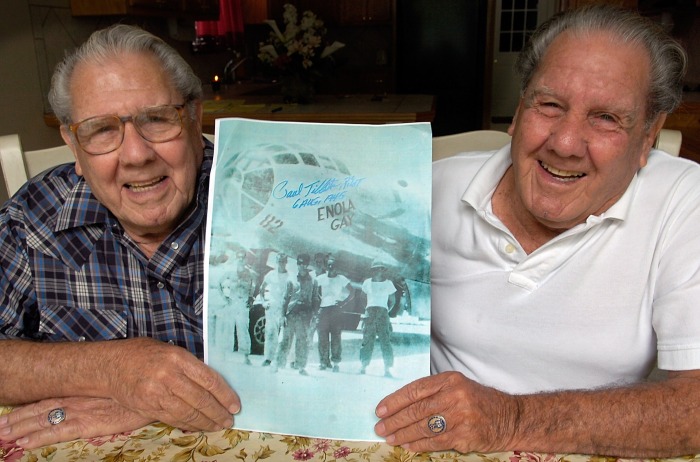 Leo Walsh spent three months as a Marine occupying Nagasaki, Japan, where the second atomic bomb blast led to Japan’s surrender. (Photo used by permission of The Advocate, Baton Rouge, Louisiana)
Leo Walsh spent three months as a Marine occupying Nagasaki, Japan, where the second atomic bomb blast led to Japan’s surrender. (Photo used by permission of The Advocate, Baton Rouge, Louisiana)
By George Morris
In more than 3½ years of combat, countless thousands of servicemen passed through Pearl Harbor, where World War II began for the United States.
Leo Walsh, of Baton Rouge, is in a more select company. He saw where it essentially ended.
Walsh was a private first class with the 2nd Marine Division when it was assigned to occupation duty at Nagasaki, Japan. There, on Aug. 9, 1945, an atomic bomb was used in warfare for the second and, so far, last time. Japan’s surrender was announced six days later.
 Stan Shaw holds a photo taken of him in a bomber cockpit during World War II. (Photo by Patrick Dennis, used by permission of The Advocate, Baton Rouge, Louisiana)
Stan Shaw holds a photo taken of him in a bomber cockpit during World War II. (Photo by Patrick Dennis, used by permission of The Advocate, Baton Rouge, Louisiana) Tom Grace was part of an Army Ranger unit that liberated more than 500 prisoners from Cabanatuan, Philippines. (Photo by Patrick Dennis, used by permission of The Advocate, Baton Rouge, Louisiana)
Tom Grace was part of an Army Ranger unit that liberated more than 500 prisoners from Cabanatuan, Philippines. (Photo by Patrick Dennis, used by permission of The Advocate, Baton Rouge, Louisiana) Conrad Meijer was a Dutch civilian teenager who spent much of World War II as a prisoner of the Japanese. (Photo by Patrick Dennis, used by permission of The Advocate, Baton Rouge, Louisiana.)
Conrad Meijer was a Dutch civilian teenager who spent much of World War II as a prisoner of the Japanese. (Photo by Patrick Dennis, used by permission of The Advocate, Baton Rouge, Louisiana.) USS Shaw explodes during the attack on Pearl Harbor, Dec. 7, 1941 (National Archives)
USS Shaw explodes during the attack on Pearl Harbor, Dec. 7, 1941 (National Archives) Roy Romano holds a photo of the USS West Virginia and crew, where he served during World War II. (Photo by Travis Spradling, used by permission of The Advocate, Baton Rouge, Louisiana)
Roy Romano holds a photo of the USS West Virginia and crew, where he served during World War II. (Photo by Travis Spradling, used by permission of The Advocate, Baton Rouge, Louisiana) Paul Dietzel holds a photo of ‘Banana Boat,” the B-29 he piloted in bombing missions over Japan in World War II. (Photo by Bill Feig, used by permission of The Advocate, Baton Rouge, Louisiana)
Paul Dietzel holds a photo of ‘Banana Boat,” the B-29 he piloted in bombing missions over Japan in World War II. (Photo by Bill Feig, used by permission of The Advocate, Baton Rouge, Louisiana)
 This flag, on display in the National Museum of the Pacific War in Fredericksburg, Texas, was made by prisoners of war held by the Japanese and is similar to one made by POWs held in Davao, Philippines, and Toyama, Japan, during World War II. (Photo by George Morris)
This flag, on display in the National Museum of the Pacific War in Fredericksburg, Texas, was made by prisoners of war held by the Japanese and is similar to one made by POWs held in Davao, Philippines, and Toyama, Japan, during World War II. (Photo by George Morris) U.S. forces in the Malinta Tunnel surrender on Corregidor.
U.S. forces in the Malinta Tunnel surrender on Corregidor.